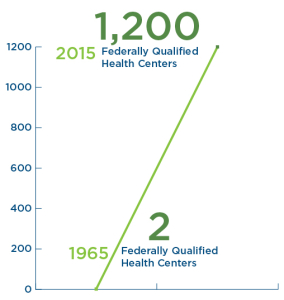
Federally Qualified Health Centers (FQHCs) trace their history back to the Neighborhood Health Centers that emerged from the Lyndon Johnson administration’s War on Poverty in 1965. That year, the first two community health centers were created at the federal level to provide health and social services in poor and undeserved communities. Over the next 50 years, FQHCs—health centers that receive grants through section 330 of the Public Health Service—have gained more and more traction in underserved areas. By the 2000s, FQHCs were equated with accessible, affordable healthcare. And by 2015, they were serving more than 23 million patients through 1,200 health centers in 9,000 communities nationwide. Today, 71% of patients served by FQHCs live at or below the poverty line.
This upsurge of FQHC formations comes on the heels of an industry trend towards value-based care and the Affordable Care Act’s allocation of $11 billion to health centers in 2010. Flash forward to 2016 and FQHCs are now our nation’s best solution for delivering quality health care to underserved rural and urban populations. Although reaching financial sustainability presents challenges for most centers of this nature, the benefits of this healthcare model are plentiful:
Federally Qualified Health Centers…
- provide affordable healthcare to uninsured and underprivileged Americans
- allow for quality care in urban and rural settings
- allow physicians with visas to be placed in underserved communities
- provide access to vaccines for uninsured children
- reduce the burden of emergency rooms
- can offer prescription and non-prescription medications for outpatients at reduced cost
- provide comprehensive services
- offer a sliding fee discount program
What’s more, these health centers perform just as well or better than private practices on 94% of quality measures.
As leaders in the healthcare industry, we are grateful for FQHCs and those who are working to expand their reach. Driven by the mission to provide healthcare access to those who might not otherwise have it, a new breed of healthcare leaders has emerged. Leaders of these organizations seek not only to improve patient-centered medical care but also to create a sustainable business model to ensure longevity within the communities they serve. And as this new profile of the successful FQHC emerges, we become closer to ensuring affordable healthcare for every American.




